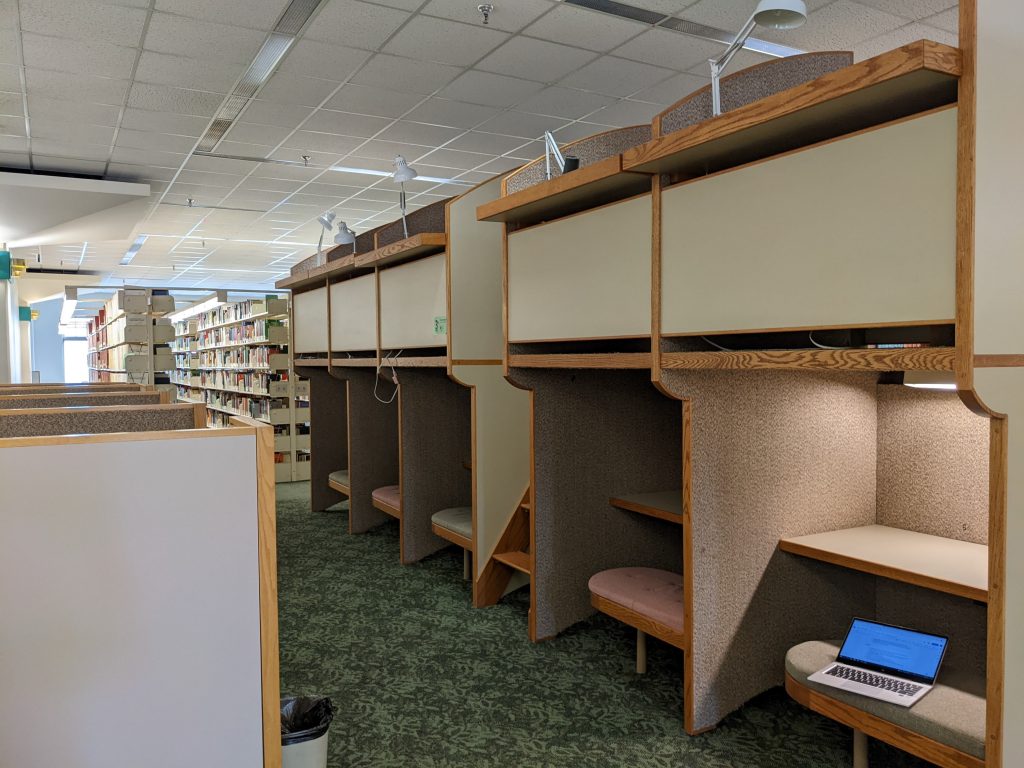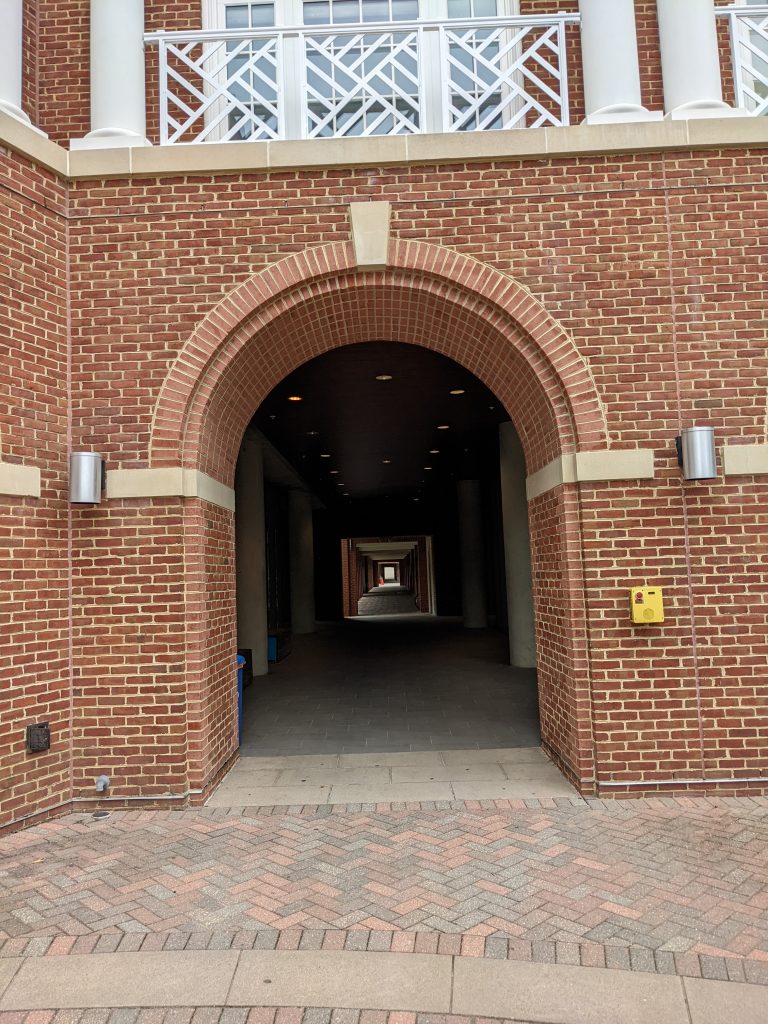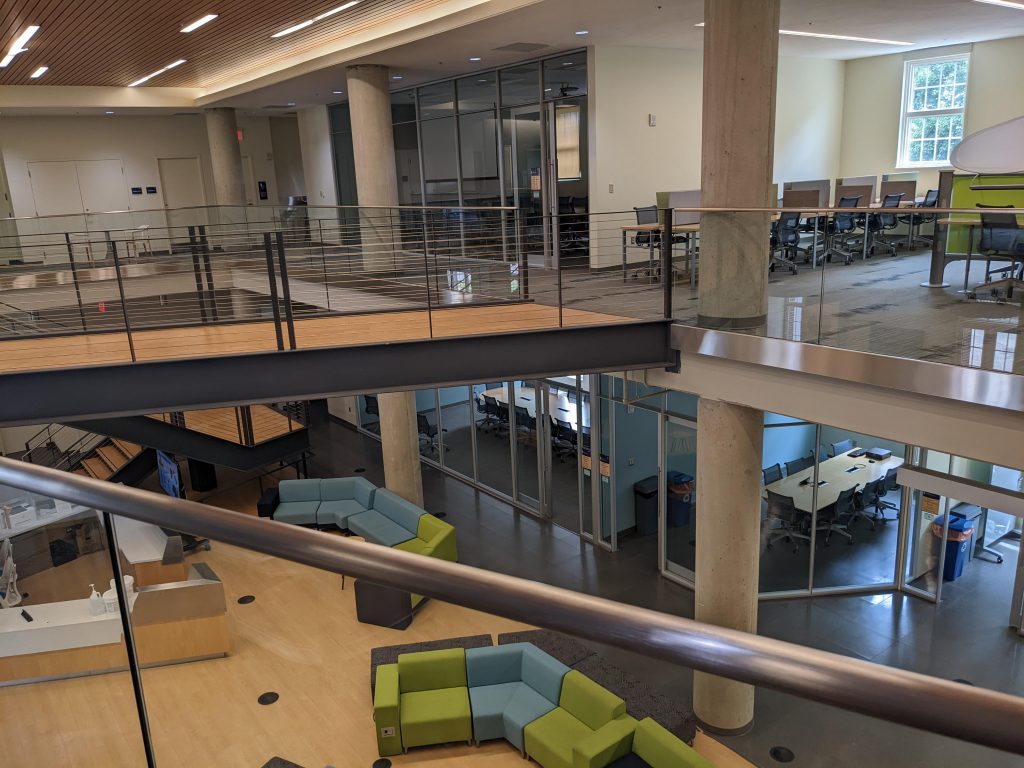The Space and Physical Access
The Simpson Library on the campus of the University of Mary Washington in Fredericksburg, VA doesn’t jump out to the visitor. It is accessed through a variety of long ramps and walkways from either the main part of campus or from the newer part of campus built in the last few years. Bike racks and the student center are nearby providing plenty of access. The red brick building is non-descript from the outside with few windows and very little signage covering its three floors, and it certainly does not fill a visitor with awe upon arrival. Upon arrival you are greeted by a circulation desk area as well as a small computer station. The inside space fails to impress with older dark lighting and fixtures, dark colored carpeting, and older institutionalized furniture scattered about in a hodgepodge arrangement of nooks and crannies. A research area with more computers and microfiche terminals completes the first floor with a small children’s section behind the central stairs. Wi-Fi is available throughout the spaces. An elevator or stairwell takes you to the other two floors where tall stacks filled with older books await. There is a small central special collections area that was locked upon my arrival. The upper floors do boast a “treehouse” area which is actually stacked study carrells from another century, but it was an unusual sight for me. There is a “convergence gallery” past old study rooms which is actually an underutilized concrete walkway that connects the older library with the spaces that have just been created. The newer spaces are huge open spaces filled with light, new flooring, bright furniture, and lots of state-of-the art collaborative spaces including a huge digital auditorium hiding behind a two-story tall barn door. Even though the new space is beautiful to see, on the day I visited it was completely devoid of people and just seemed to lack any sort of organization or cohesiveness to give it a soul.


Digital Access
Accessed by visiting libraries.umw.edu, the UMW library site is divided into the Simpson library and Special Collections. The webpage is simple to navigate and relies mostly on text and plain backgrounds instead of lively buttons and images. The catalog, databases, and journal search engines sit prominently on the home page along with how-to guides, video tutorials, research guides, as well as contact information. The library serves the UMW students and faculty, but it is open to the public and also serves visiting students through the VIVA Cooperative Borrowing Program which allows other university students to access books and resources. A variety of services from e-books to room reservations is readily available from the main page. A quick look at the staff directory reveals that the staff is pretty small (18 positions). A “systems and discovery services librarian” jumps out as an interesting job title. The site uses a website accessibility tool called Monsido that floats as a purple icon on pages to let you adjust a variety of settings to help with accessibility.
Services and Intellectual Access
The library appears to be organized using the Dewey Decimal system, and includes a special collections room focusing on rare books and journals, the University archives, and a special digital collection. The library doesn’t have an abundance of signage and a focus on diversity is not abundantly clear when walking the building. I didn’t notice a lot of information or signage about services or getting help with tools, etc.
People (Patrons and Staff)
The library is open to all but serves predominantly the University students and staff. The classrooms, labs, computers, and collaborative spaces all seem to require a University ID or login to reserve. During my visit (a weekday in early July) I saw two staff members – someone working the front desk and someone working in the digital archiving lab. Making my way through the spaces I was able to find one person sitting in a carrel doing research. As I mentioned earlier, on this particular visit the library felt cold and soulless and gave off the air of an antiquated relic waiting to be unearthed again. Perhaps when students and faculty return in abundance they will breathe life into the space. There are a number of interim positions listed in the staff directory, so I wonder if that also contributes to the lack of feeling and direction with the space.
Collections

Simpson leases its popular fiction and non-fiction collection, and it’s main collection consists of 500,000 volumes, maps, DVDs, 50 databases that support the 180 databases available through VIVA collection. The library also has over 100,000 online books. The library has photography and headphone kits available for checkout. A mix of Windows computers and newer Macs were scattered about in different configurations with USB charging ports built into most of the seating in the newer part of the library. Accessing the wireless required registering for a free daily guest pass using your device. It was a simple process but could scare some users away.
Other
What is Simpson like during the fall when students are researching and writing papers? How are students using the variety of collaborative spaces spread out through the newer building? Just what can you do in a digital auditorium that you can’t do in a normal auditorium. These are the burning questions I have about the UMW library. I like my quiet, empty spaces, but I really am curious just what this library’s personality is. Ohler and Pitts (2021) discuss a shift “from repository of the scholarly record to scholarly communication institute” (“Industry as model, not enemy” section). The Simpson library seems to suffer from being stuck in the middle of that shift with a split personality, and I’d love to know just what that is a function of and how long the shift will manifest itself physically as it has at Simpson.
References
Ohler, L., & Pitts, J. (2021, January). From peril to promise. College & Research Libraries News. 82(1), 41. https://crln.acrl.org/index.php/crlnews/article/view/24772/32618
Wow, that does look like an old and maybe not so fun library. I wonder if it being an academic library, they are keeping it like that on purpose to instill a sense of “this is where you work, not play” type of thing. It is a little sad for the students that it isn’t more updated. I guess that could also be a funding issue. I am glad that there is a lot of access to digital databases and collections as I’m sure students these days are more likely to access online material rather than print material.
Ok, I completely missed the newer spaces when I visited this library. Were they hiding somewhere obvious? If so, I feel pretty unobservant. Geez. I agree with you that it feels like an old relic–I didn’t love the space or the feel of it, and the location is terrible. The lesson I learned from visiting was “stick to the website” (and also, get a job in a renovated library if you go the academic route).
Yeah, it feels like it just hasn’t had the funding or maybe the leadership to figure out what direction to go in. The newer part is easy to miss unless you go up to the 2nd floor to that connecting hallway.
It looks like it has a lot of open space which is nice and having charging stations built in the furniture is a great idea. My guess is that summer school enrollment is probably not high, thus very little traffic in the library. But it would be nice to know how busy it is during the fall or spring semester. I’m surprised they use dewey decimal, I thought that most academic libraries used LOC. I think the treehouses concept is kind of neat and almost fun. So why do you guess there are so many “interim” positions? Are they in a hiring freeze or are they just temporary positions? It doesn’t seem like the number of staff is enough for a busy library!
I have to go back and look at the image I took of one of their stacks because now you have me second-guessing myself on how they organize. As far as the interim positions, I’m wondering if it was a post-covid drop sort of like we have seen in the K-12 world. I’m not sure how it has affected higher-ed, but I think I read that enrollments in colleges is dropping as people start to look in other directions for what they want to do after high school.
As I was reading your observations and looking at the pictures I was thinking the same thing about it being somewhat underwhelming. The space looks fine but the energy is missing. You know the more I visit different libraries, the more I think that the librarian’s attitudes and professionalism give the library heart. A couple of bright green chairs don’t really rise the vibe. It would be interesting to visit in the fall when students are filling the tables.
While I love old book smell, I too question the lack of visibility of this library. Usually, the main library is prominently displayed on a college campus and is often a selling point. While that corridor provides a Secret Garden-esque portal 11 year old me would love, I don’t think it functions well as a gateway to the campus’ main library. I also wonder what it looks like in the fall and, in fairness, what it looked like before Covid.
Interesting to see this space – not a single piece of art or decoration on the walls in your photos.
Just a note re: some of the other comments I’m reading, since I currently work as a higher ed enrollment researcher! College enrollment is down since COVID, especially at the community college level, but four-year institutions have not been spared with the exception of highly selective institutions. These enrollment drops have negatively affected the revenue of institutions who have a high share of their revenue coming from tuition payments (usually smaller institutions with smaller endowments), in addition to federal CARES Act funding ending, which have put major stressors on faculty, staffing, and scholarship funding. Not sure if this is what’s happening at UMW, but it’s definitely a ripple effect across higher ed, in many cases leading to some colleges having to close their doors during the pandemic.